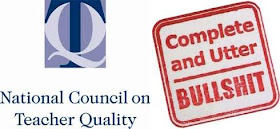NCTQ on States’ Teacher Evaluation Systems’ Failures

The controversial National Council on Teacher Quality (NCTQ) — created by the conservative Thomas B. Fordham Institute and funded (in part) by the Bill & Melinda Gates Foundation as “part of a coalition for ‘a better orchestrated agenda’ for accountability, choice, and using test scores to drive the evaluation of teachers” (see here; see also other instances of controversy here and here) — recently issued yet another report about state’s teacher evaluation systems titled: “Running in Place: How New Teacher Evaluations Fail to Live Up to Promises.” See a related blog post in Education Week about this report here. See also a related blog post about NCTQ’s prior large-scale (and also slanted) study — “State of the States 2015: Evaluating Teaching, Leading and Learning” — here. Like I did in that post, I summarize this study below.
From the abstract: Authors of this report find that “within the 30 states that [still] require student learning measures to be at least a significant factor in teacher evaluations, state guidance and rules in most states allow teachers to be rated effective even if they receive low scores on the student learning component of the evaluation.” They add in the full report that in many states “a high score on an evaluation’s observation and [other] non-student growth components [can] result in a teacher earning near or at the minimum number of points needed to earn an effective rating. As a result, a low score on the student growth component of the evaluation is sufficient in several states to push a teacher over the minimum number of points needed to earn a summative effective rating. This essentially diminishes any real influence the student growth component has on the summative evaluation rating” (p. 3-4).
The first assumption surrounding the authors’ main tenets they make explicit: that “[u]nfortunately, [the] policy transformation [that began with the publication of the “Widget Effect” report in 2009] has not resulted in drastic alterations in outcomes” (p. 2). This is because, “[in] effect…states have been running in place” (p. 2) and not using teachers’ primarily test-based indicators for high-stakes decision-making. Hence, “evaluation results continue to look much like they did…back in 2009” (p. 2). The authors then, albeit ahistorically, ask, “How could so much effort to change state laws result in so little actual NCTQ on States’ Teacher Evaluation Systems’ Failures | VAMboozled!:
